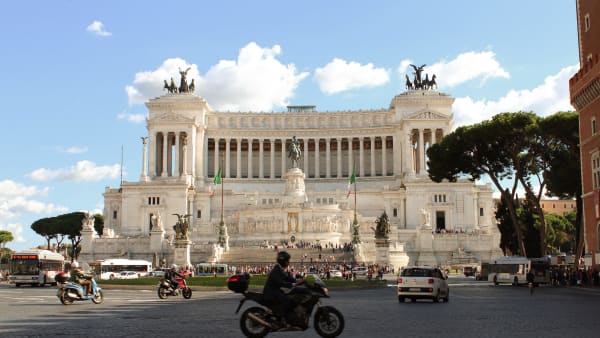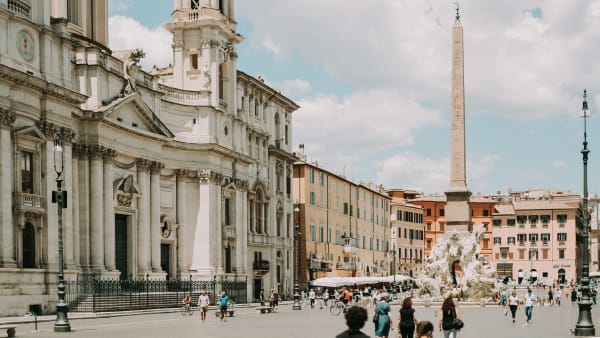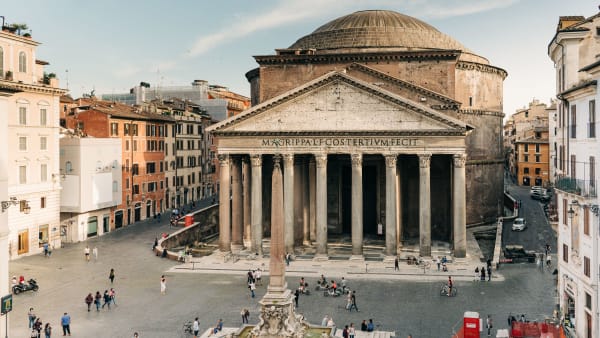Curiosities
Curiosities
Did you know that the Palatine was an essential site for the creation of the Eternal City? And that in honor of this exact location, a great feast was celebrated for 1200 years? Read on to discover all kinds of curiosities about the Palatine!
The Lupercal and the origins of Rome
According to Roman mythology, the twins Romulus and Remus, the founders of Rome, were sons of Mars (god of war) and Rhea Silvia (priestess of the goddess Vesta, who had to maintain her virginity).
It’s said that the newborns, conceived in sin, were placed in a basket by a slave and carried away with the current of the Tiber river. The basket was eventually stranded in a cave, where the twins were found and suckled by a wolf.
This cave, the Lupercal (Grotta della Lupa), is therefore considered a sacred place and the origin of the Eternal City. Once grown up, the two brothers decided to build a city along the river, but because they couldn’t agree, Romulus killed his brother and founded the city of Rome. Today, a bronze statue of a wolf suckling two newborns stands in the area as a reminder of the myth.
Earlier, in the time of the Arcadians, the Pan cult had been established in the Lupercal, in honor of Pan Lyceus, god of nature and wild animals, especially wolves and goats. In addition to an altar and statue dedicated to this god, sacrificial rituals took place in February. These are discussed in more detail in the next section of this article.
Lupercalia, the Roman fertility festival
For 1200 years, the Lupercalia was celebrated from February 13 to 15. The origin of the festival and its purpose are related to the fertility of women and nature. Furthermore, it had characteristics of what we know today as Valentine’s Day and Carnival.
The image of the Lupercalia is that of young men, scantily clad in furs, hounding women by beating them with strips of goatskin to obtain fertility. It was one of the most uninhibited Roman festivals and, together with the Saturnalia, which took place in December, gave rise to carnival.
The origin of the feast has two stories, from three authors: the historian Dionysius of Halicarnassus and the poet Ovid, who lived during the reign of Augustus; and the writer Plutarchus, almost a century after them.
According to Dionysius and Plutarch, the festival was originally related to a Greek ritual from the region of Arcadia. It’s believed to have been dedicated to the god Pan Lyceus. According to this version, it was originally a running race in honor of the god to ask him to keep the wolves away from the herds; hence, the participants were dressed in goatskins and wolf masks.
However, according to Ovid, its origin dates back to the time of Romulus, the founder of the city. Legend has it that during his reign a prolonged episode of infertility occurred among Roman women, who were making a pilgrimage to the sacred forest of the goddess Juno. She’s said to have replied that they should be “pierced by the sacred goat,” an allusion to the Faunus god Lupercus, deity of flocks and forests. An Etruscan soothsayer interpreted the prophecy, sacrificed a goat, and struck the women on the back with the goat’s skin. After ten moons (about nine solar months) they gave birth.
The secret garden of the Palatine
In 2018, when the restoration of the Uccelliera Farnese on the Palatine was completed, an exhibition curated by architect Giuseppe Morganti for the first time showcased one of the most famous and symbolic places of Renaissance and Baroque Rome: the Farnese Gardens.
The gardens, created from the middle of the sixteenth century by Cardinal Alessandro Farnese, were a means of definitively consolidating the status and political position that the family had acquired. It’s no coincidence that this city, which includes the imperial palaces, was created on the site where Rome was founded and where imperial power was established from Augustus onwards.
The exhibition told the story from Farnese’s green project to the beginning of the 20th century, when archaeological excavations began. To revive the charm of the old garden, laurels, cypresses, yews, citrus trees, vines, and damask roses were planted. The result was one of the first botanical gardens in Europe and also the richest in the world.
Two very valuable statues from the Farnese collection of the National Archaeological Museum in Naples, the kneeling Barbarian and Isis Fortuna, were exhibited in the Uccelliera Farnese, marking their return to this site for the first time. Two giant busts of captured Dacians were also on display.
The purpose of the exhibition was to enrich the path with the use of digital technologies. In the Nymphaeum of Rain, one of the spaces of pleasure and recreation designed by the Farnese family, a fascinating journey through time was set up through the use of multimedia equipment, which reconstructed the original appearance of the gardens.
The myth of Hercules and Cacus
The gradual incorporation of Hellenistic culture into the primal cultures of Italy is expressed through, among other things, the myth of Hercules and Cacus. The demigod Hercules, son of Jupiter (Zeus to the Greeks) and a mortal woman, who symbolizes courage and strength, but also humanity and generosity, faces Cacus, a monstrous and uncivilized shepherd, son of the god Vulcan.
The Roman historians who reconstructed archaic events and transmitted them to us tried to insert an element of continuity between the Greek and Roman civilizations through the figure of Hercules. To this end, the demigod clashed with the Italian gods whom, when he couldn’t restrain himself, he destroyed.
The myth reads as follows. When Hercules returned from Iberia with his oxen, he walked through the valley of the Tiber and asked Evander (son of Mercury and the nymph Carmenta), leader of the Arcadian community long established on the Palatine, for shelter.
As his red oxen grazed peacefully in the valley, they were stolen by the monstrous, fire-breathing shepherd Cacus, who lived in a den of the Aventine hill. Hercules eventually found his oxen and killed Cacus. Evander then decided to build a temple in honor of the demigod who had freed him from the terrible Cacus.
The legend is thus based on the clash between two mythological figures who, once the confrontation has begun, both turn out to be connected to the salt trade and to trade in general. Cacus is a chief, a barbarian robber who dominates the Salara road and its herds, Hercules is the Heracles of the Greeks who protects the ancient salt road that runs from Piceno to the mouth of the Tiber.
Cacus and Hercules symbolically represent the evolution of the area between the Palatine and the Aventine, close to the mouth of the Tiber River, which was a trading area. Chronologically, Cacus, the deity of the settled Middle Bronze Age tribes, presided over the proto-urban phase, when settlements began to expand between the Capitoline and the Palatine. In the next phase, with commercial transactions, the cult of Hercules emerged.
The birth of the hill
Given the importance of this hill to the birth of the city, it seemed appropriate to include some information about its origin. It seems that in the Neozoic, volcanoes erupted in Latium and deposited layers of sand, clay, and gravel on the soil, forming tuffs on which silt and clay of fluviatile and lacustrine origin were deposited.
This created a hill about 50 m above sea level, the top of which was flat, crossing the Forum Boarium and the Tiber to the south, with a slope named Germalus. The hill was additionally connected to the Esquiline hill behind it by a slope, the Velia.
The water had carved out large valleys on three of the four sides of the hill and the entire promontory was surrounded by streams and rivers, in the eastern part of the mountain was then the Velabro swamp, located between the Roman Forum and the Tiber, which often caused floods in the adjacent areas.
In the valley that would later lead to the Roman Forum, a stream flowed, which in monarchic times turned into the Cloaca Maxima (sewer), while springs such as those of the Lupercal or the Giuturna sprang up on the slopes of the hill. Furthermore, the land was covered with forests of oaks, beeches, cypresses, figs, laurels, shrubs, and streams.
As mentioned in the historical section of this article, it’s precise because of these favorable conditions that the Palatine is considered the cradle of Roman civilization, where the first settlements and the urban body of the city emerged.
The origin of the name
In ancient times, the Palatine was called “Palatium”. Some say the name derives from Pallantion, a city in Arcadia from which Prince Evander, a figure in Roman mythology and son of the god Mercury and the nymph Carmenta, and his people emigrated.
According to other hypotheses, the name of the hill is derived from Pallas, an ancestor or son of Evander. Others believe that the name is derived from Pales, goddess of shepherds, or Palatium, a mythical city in Sabina.
In the imperial period, the term Palatium began to designate the imperial palace par excellence. It’s noteworthy that this word initially referred only to the imperial residence, but was later expanded into a general designation, denoting the palace as a generic structure in all European languages.
The origins of Christmas
The idea of replacing the Roman feast of the Invincible Sun (Natalis Solis Invicti) with the feast of the birth of Christ came from Constantine, the emperor who granted freedom of religion to Christians.
However, he was also responsible for the first celebration of the birth of Christ, which took place in 326 AD in the church of St. Anastasia. A basilica that had been built by the emperor in honor of his half-sister on the Palatine in the late 3rd century, early 4th century.
Since the capital had already been moved to Constantinople, one may wonder why this choice was made; some scholars suggest that the reason is that the Lupercal is located next to the basilica. With this political decision, the emperor imposed a turn in the history of Christianity.















